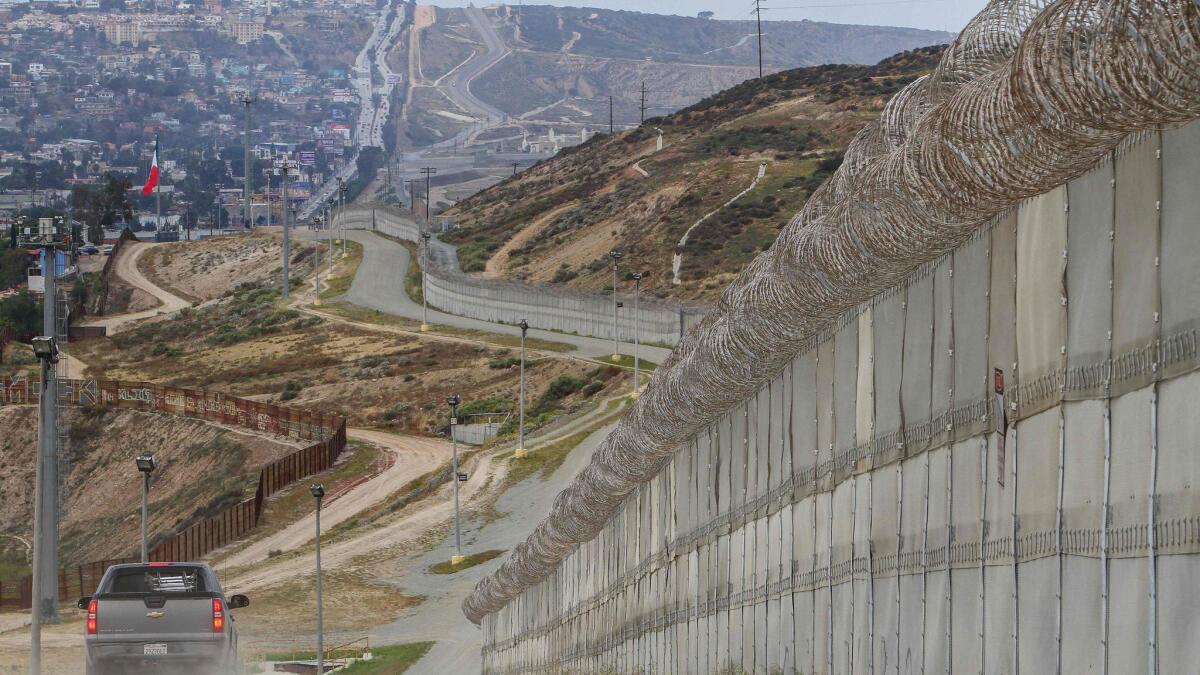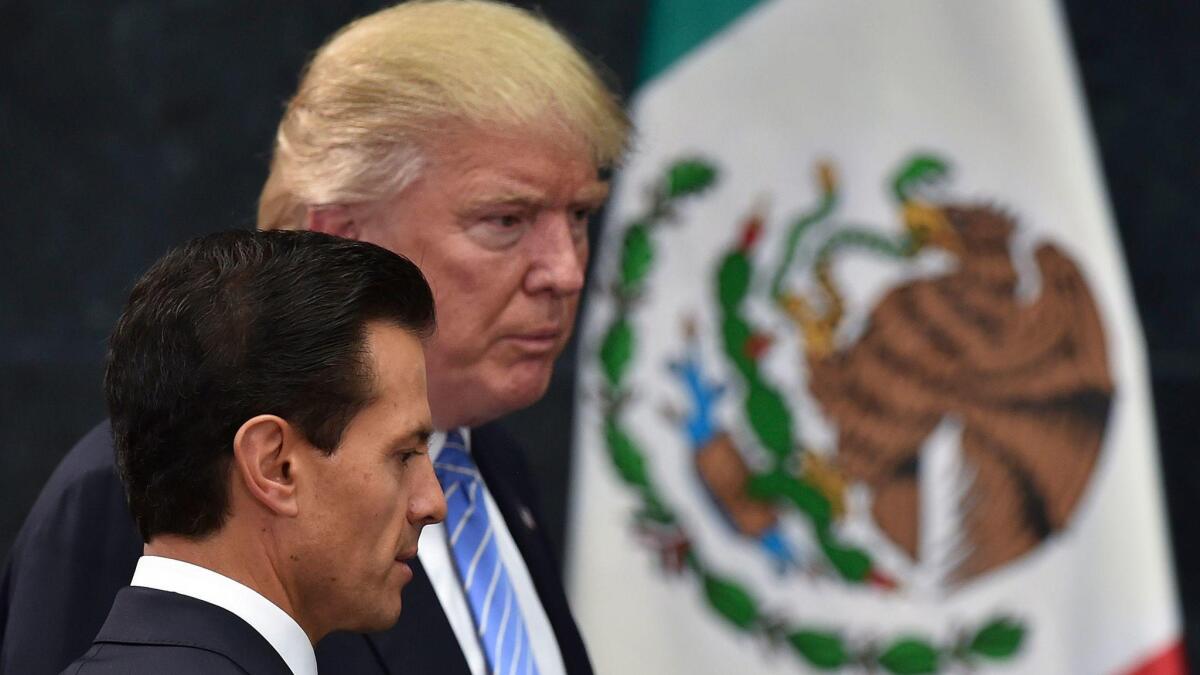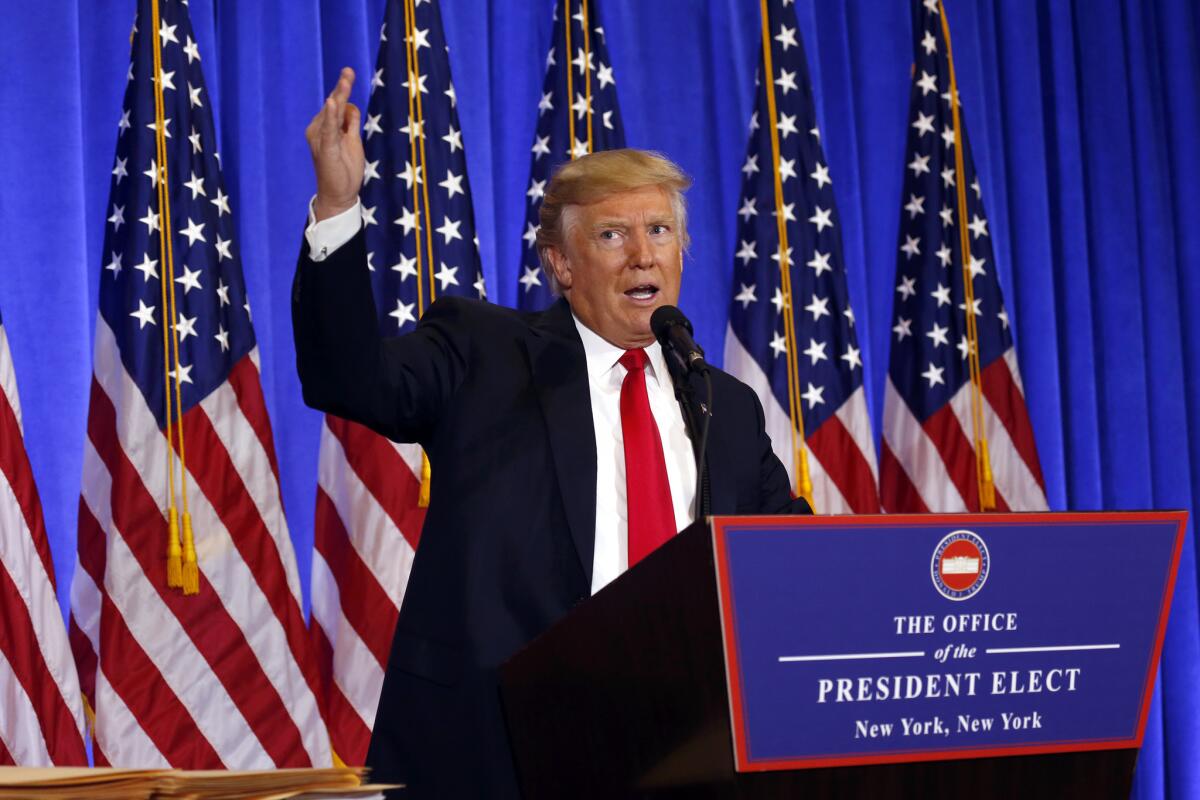Trump still says he’ll make Mexico pay for his border wall, but can he really?

It’s by now a predictable pattern.
Every few days, President-elect
And each time, Mexican leaders respond the same way.
“Neither today, nor tomorrow nor never Mexico will pay for that stupid wall. If Trump wants a monument to his ego, let him pay for it!!” former Mexican President Vicente
“There is no way,” Luis Videgaray, Mexico’s new foreign secretary, said this week. For Mexico, he said, the wall issue is “a matter of national dignity and sovereignty.”
Trump has vowed to begin construction on the wall soon after his Jan. 20 inauguration. He plans to press
The caustic back and forth between Trump and top Mexican officials, which along with fears of a trade war this week sent the value of the peso plunging to record lows, raises the question: Can Trump really force Mexico to pay for the wall?
We talked to several experts about that — as well as what Trump’s threats against Mexico could mean for the economies of both countries.
Will Trump be able to persuade Mexico to pay for the wall?
“The Mexican government isn’t willing to pay for the wall in any way,” said Alfredo Coutiño, Latin America director for Moody’s Analytics.
Mexican President Enrique Peña Nieto reaffirmed that sentiment in a speech Wednesday, saying “of course” Mexico won’t fund the wall.
Handing over billions of dollars for the construction of the wall would be political suicide for Peña Nieto, who saw his approval ratings sink after he met with Trump in Mexico City last fall.
But besides that, there is a more practical concern.
“Mexico doesn’t have the money to pay for it,” said Coutiño. An already shaky economic situation was made more unstable Jan. 1 when the Mexican government suddenly deregulated gasoline prices. Gas prices rose as much as 20%, triggering angry demonstrations across the country.
In recent weeks, Trump has acknowledged that it is unlikely the U.S. would receive a direct payment from Mexico, whose economy has been plagued by slow growth and rising inflation.
“Mexico, in some form, and there are many different forms, will reimburse us,” Trump said Wednesday. “That will happen, whether it's a tax or whether it's a payment.”
“Probably less likely that it's a payment,” he added.

How could the U.S. try to recoup the costs?
One way is taxing remittances, an idea Trump has floated in the past.
In 2015, Mexico received nearly $25 billion in remittances from citizens living outside the country, most of them from the U.S., according to the Bank of Mexico, the country’s central banking system. Trump has suggested much of that money is sent from people who are living in the United States illegally, although according to PolitiFact, there is no way to track the legal status of remittance senders.
If Trump pushed Congress to approve, say, a 10% tax on remittances, that could generate $10 billion dollars for the U.S. government over four years.
Trump could “slice and dice” the situation to make it appear that Mexico is paying a tax to fund a border wall, said Edward Alden, a senior fellow specializing in U.S. trade policy at the Council on Foreign Relations. But ultimately, it would be Mexican immigrants who were paying.
“It’s an ugly and regressive tax, because you’re essentially taxing poor people,” Alden said.
Is there a precedent for taxing remittances?
Yes, at least on the state level. Since 2009, Oklahoma has charged a 1% fee — critics call it a tax — on all personal wire transfers of cash to accounts outside the state.
The fee is a withholding on state income tax, and when residents file taxes, they eventually get the money back. However, those in the country illegally who send money abroad do not receive the cash back — a move that in effect taxes them.
Could the U.S. only target remittances sent to Mexico?
That could be difficult. Any federal tax on remittances probably would have to be applied across the board to people sending money to all countries, analysts say.
“Taxing one specific group of people on their remittances could be considered discriminatory,” said Christopher Wilson, deputy director of the Mexico Institute at the Wilson Center in Washington.
What about Trump’s pledge to tax imports from Mexico?
With the help of Congress, Trump could immediately impose new taxes on goods imported to the U.S. from Mexico. He could claim that is one way Mexico is paying the costs of the wall.
But new taxes could draw lawsuits, Wilson said, because the
Trump has pledged to immediately start renegotiating that deal to make it more fair for American workers, but that process could stretch years.
How would changes to free trade deals affect the economy?
Canceling or making serious changes to NAFTA could paralyze major American industries, like the automotive and food and beverage sectors, Coutiño said. If that happens, “the U.S. runs the risk of going into recession.”
The consequences for Mexico also could be devastating.
“Mexico would almost certainly go into recession, too,” Coutiño said, because Mexico’s faltering economy would limit officials’ ability to lower interest rates and pump money into the economy like U.S. leaders did during the Great Recession.
A recession in Mexico, Coutiño said, could unleash major unintended consequences in the U.S. that could ultimately undermine Trump’s efforts to even the trade playing field and limit illegal immigration.
“In indirectly inducing the weakening of the peso, Trump is making Mexican exports more attractive for American consumers,” Coutiño said.
“If you block Mexico in terms of exports, investing and remittances, Mexico’s economy is going to sink, unemployment is going to rise, and guess what? More Mexicans are going to be willing to take the risk of crossing the border into the U.S.,” Coutiño said.
“Trump is running the risk of increasing immigration from Mexico.”
This would create a certain irony. Though Central Americans have been trying to reach the U.S. in greater numbers, net migration from Mexico has remained zero for several years, with U.S. and Mexican government data showing more people returning home to Mexico than entering the U.S. illegally each year.
What can Mexico do about Trump’s plans?
Mexico has little say in several of the changes Trump has proposed.
There is nothing Mexico could do to block a tax on remittances. And although it could impose trade tariffs on imports from the U.S., that would not have a big effect because Mexico exports more than it imports.
On Wednesday, Peña Nieto suggested that if Trump tries to punish Mexico on trade or other fronts, Mexico may push back by leveraging its cooperation with the U.S. on critical issues, such as immigration and security.
In recent years, Mexico has stepped up enforcement efforts along its southern border to help the U.S. slow immigration from Central America and other parts of the world. Between October 2014 and May 2015, for example, Mexican authorities detained more Central American migrants than the U.S. Border Patrol.
Moreover, Mexico and the U.S. collaborate closely on security issues, from intelligence sharing between law enforcement agencies to the Merida Initiative, a bilateral partnership forged in 2007 to help reduce the power of drug trafficking in Mexico. Since then, the U.S. has contributed more than $2 billion to Mexico in police training and cash for better security equipment.
But the effectiveness of using security and immigration as bargaining chips is questionable, experts say, in part because U.S. funding for those efforts is also in Mexico’s interest.
That leaves Mexico, Coutiño said, “basically at the mercy of the U.S.”
“The most likely scenario is that the Trump administration will find some way to claim that they have forced Mexico to pay for the additional border fencing,” Wilson said. “And Mexico will claim that it was paid for by Congress and the Trump administration.”

Linthicum reported from Mexico City and Lee from Los Angeles.
Twitter: @katelinthicum
ALSO
Trump alleges leaks by U.S. spy agencies, something ‘Nazi Germany would have done’
What Trump made clear at his news conference and what he left murky
Trump was at home for his news conference – both literally and figuratively
UPDATES:
2:05 p.m., Jan. 12: This article was updated with comments from Mexican President Enrique Peña Nieto.
This article was originally published on Jan. 11 at 4:29 p.m.
Sign up for Essential California
The most important California stories and recommendations in your inbox every morning.
You may occasionally receive promotional content from the Los Angeles Times.









